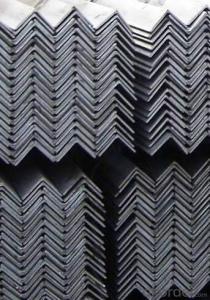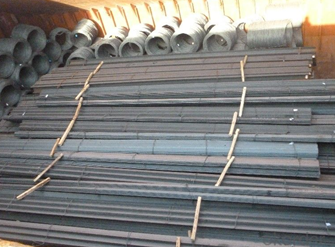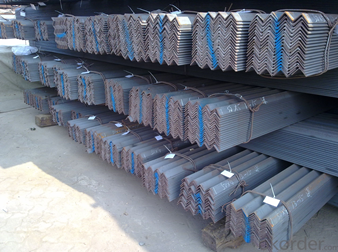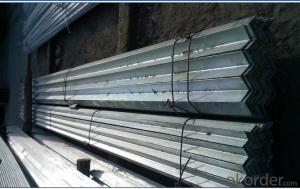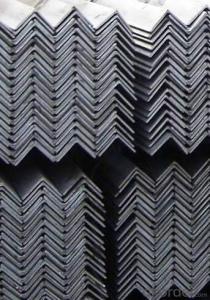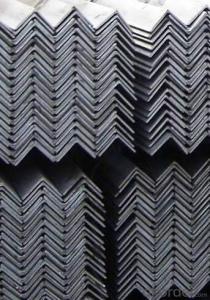GB STANDARD HIGH QUALITY HOT ROLLED ANGLE BAR
- Loading Port:
- Tianjin
- Payment Terms:
- TT OR LC
- Min Order Qty:
- 50 m.t.
- Supply Capability:
- 5000 m.t./month
OKorder Service Pledge
OKorder Financial Service
You Might Also Like
Product Description:
Specifications of Hot Rolled Steel Rebar:
The production process of Steel Rebar
1-Waling beam furnace 2-Roughing rolling group 3-Intermediate rolling train
4-Finishing rolling group 5-Water-cooling device 6-Walking beam cooler
7-Finishing equipment(including the cold scale shear,short feet collection system,
automatic counting device,bundling machine, collect bench)
Usage and Applications of Hot Rolled Steel Rebar:
Deformed bar is widely used in buildings, bridges, roads and other engineering construction. Big to highways, railways, bridges, culverts, tunnels, public facilities such as flood control, dam, small to housing construction, beam, column, wall and the foundation of the plate, deformed bar is an integral structure material. With the development of world economy and the vigorous development of infrastructure construction, real estate, the demand for deformed bar will be larger and larger..
Packaging & Delivery of Hot Rolled Steel Rebar:
Packaging Detail: products are packed in bundle and then shipped by container or bulk vessel, deformed bar is usually naked strapping delivery, when storing, please pay attention to moisture proof. The performance of rust will produce adverse effect.
Each bundle weight: 2-3MT, or as required
Payment terms: TT payment in advance or Irrevocable LC at sight.
Trade terms :FOB, CFR, CIF
Label:to be specified by customer, generally, each bundle has 1-2 labels
Note:
1. Our products are produced according to national standard (GB), if not, supply according to national standards (GB) or agreement as customer required.
2. Other Grade and Standard Deformed Steel Bar we can supply:
Grade: GR40/GR60, G460B/B500A/B500B/B500C,BST500S
Standard: ASTM, BS, DIN
The Minimum Order Quantity of these products is high, and need to be confirmed.
3. We can not only supply Deformed Steel Bar; if you need anything about building materials, please contact us for further information.
4. Please send us your detail specifications when inquire. We will reply to you as soon as possible. We sincerely hope we can establish a long stable business relationship.
- Q: Can steel angles be used in earthquake-resistant building designs?
- Yes, steel angles can be used in earthquake-resistant building designs. Steel angles are commonly used in construction due to their strength and stability. When properly engineered and integrated into the design, steel angles can provide additional support and reinforcement to the building structure, making it more resistant to seismic forces during an earthquake.
- Q: What are the common design codes and standards for steel angles?
- The specific application and industry requirements determine the common design codes and standards for steel angles. Various recognized design codes and standards are applicable to steel angles, including: 1. The American Institute of Steel Construction (AISC) offers design specifications and standards for structural steel construction, including angles. The AISC Steel Construction Manual provides guidance on designing steel structures and selecting steel angles. 2. The American Society for Testing and Materials (ASTM) develops and publishes technical standards for different materials, including steel. ASTM A36/A36M is a commonly referenced standard for carbon structural steel, including angles. It specifies requirements for chemical composition, mechanical properties, and testing methods. 3. The European Norm (EN) specifies technical delivery conditions for structural steel products. EN 10025-2 covers non-alloy structural steels, including angles, and provides requirements for chemical composition, mechanical properties, and tolerances. 4. The British Standards Institution (BSI) publishes standards related to steel angles, such as BS EN 10056-1. This standard details the dimensions and tolerances for hot-rolled equal and unequal steel angles. 5. The Canadian Standards Association (CSA) provides guidance for steel design and construction in Canada. CSA G40.21 is a widely used standard that covers requirements for general structural steel, including angles. It is important to note that these examples represent common design codes and standards for steel angles. Depending on the project and location, additional local or industry-specific codes and standards may need to be considered. Consulting a structural engineer or referring to relevant design codes and standards is crucial for ensuring compliance and safety in steel angle design and construction.
- Q: Are steel angles suitable for manufacturing support brackets for pipes?
- Steel angles, indeed, are a fitting choice for fabricating support brackets for pipes. Renowned for their robustness and longevity, steel angles emerge as an optimal material for bolstering substantial loads, like pipes. They furnish exceptional structural reinforcement and exhibit the capacity to endure the weight and pressure exerted by pipes. Furthermore, steel angles boast resistance against corrosion, a crucial attribute when confronted with pipes that may encounter moisture or chemicals. Their adaptability permits an array of design alternatives, simplifying the customization of support brackets to accommodate specific pipe sizes and configurations. In conclusion, steel angles offer a dependable and pragmatic alternative for manufacturing support brackets for pipes.
- Q: Can steel angles be used in HVAC ductwork installations?
- Yes, steel angles can be used in HVAC ductwork installations. They are commonly used to provide structural support and reinforcement to the ductwork system, ensuring stability and durability. Steel angles can be easily integrated into the ductwork design, facilitating efficient installation and improving overall system performance.
- Q: How are steel angles used in construction?
- Steel angles are commonly used in construction to provide structural support and stability. They are often used as braces, struts, or beams to reinforce the framework of buildings, bridges, and other structures. Steel angles can also be used as corner supports, especially in the construction of walls and ceilings. Their versatility and strength make them an essential component in various construction applications.
- Q: Can steel angles be used for manufacturing outdoor benches?
- Outdoor benches can indeed be manufactured using steel angles. These angles possess remarkable strength and durability, rendering them highly suitable for outdoor settings where benches may face harsh weather conditions. Moreover, it is effortless to weld steel angles together, allowing for the creation of a robust frame for the bench. This steel frame can then be combined with alternative materials like wood or metal slats to fashion the seating surface. In summary, steel angles are widely favored when it comes to manufacturing outdoor benches due to their exceptional strength, durability, and versatility.
- Q: How do you prevent galvanic corrosion in steel angles?
- One way to prevent galvanic corrosion in steel angles is by applying a protective coating or paint to the surface of the steel. This coating acts as a barrier between the steel and any other metal that may come into contact with it, thus inhibiting the electrochemical reaction that leads to galvanic corrosion. Additionally, using non-metallic or non-conductive materials between dissimilar metals can also help prevent galvanic corrosion. Regular inspection and maintenance to identify any signs of corrosion and taking appropriate measures promptly can further prevent the occurrence of galvanic corrosion in steel angles.
- Q: What is the keel of the aluminum single board suspended or the welded frame of angle steel?
- Light steel keel, is a kind of new building materials, with the rapid development of China's modernization construction, light steel keel is widely used in hotels, airport lounges, car transport station, station, amusement parks, shopping malls, factories, office buildings, building renovation, interior decoration, ceiling set of old buildings and other places. Light steel (paint) keel ceiling has light weight, high strength, adapt to waterproof, shock, dust, sound insulation, sound absorption, constant temperature and other effects, but also has the advantages of short construction period, simple construction and so on.
- Q: Can steel angles be used for manufacturing furniture?
- Indeed, furniture can be manufactured using steel angles. These angles possess versatility and durability, rendering them appropriate for a range of uses, including furniture production. They can be employed to fashion robust and stable frameworks, legs, and supports for an array of furniture items, such as tables, chairs, shelves, and cabinets. Renowned for their strength and structural soundness, steel angles are an exceptional option for furniture that must endure heavy loads or have an extended lifespan. Moreover, steel angles can be effortlessly welded, cut, and molded to meet specific design specifications, facilitating customization and fostering creativity in furniture manufacturing.
- Q: Are steel angles suitable for agricultural applications?
- Yes, steel angles are suitable for agricultural applications. They are commonly used in the construction of agricultural buildings, fences, and equipment due to their strength, durability, and versatility. Steel angles provide stability and support, making them ideal for various agricultural tasks such as framing structures, reinforcing corners, or creating sturdy connections.
Send your message to us
GB STANDARD HIGH QUALITY HOT ROLLED ANGLE BAR
- Loading Port:
- Tianjin
- Payment Terms:
- TT OR LC
- Min Order Qty:
- 50 m.t.
- Supply Capability:
- 5000 m.t./month
OKorder Service Pledge
OKorder Financial Service
Similar products
Hot products
Hot Searches
Related keywords
